HIGHLIGHTS
- Drilling on the 50%-owned Malmsbury gold project (“Malmsbury Project”) joint venture with ASX-listed GBM Resources Ltd. (“GBM”), located 50 km SSW of the high-grade Fosterville gold mine in Victoria, Australia, has intersected a significant high-grade gold mineralized zone.
- Significant results received to date include 14 m @ 6.1 g/t Au from 120 m, 10 m @ 4.9 g/t Au from 173 m and 4 m @ 8.6 g/t Au from 188 m (MD16); 7.8 m @ 3.6 g/t Au from 32.2 m (MD13); and 9.1 m @ 2.4 g/t Au from 65.4 m (MD14). These results are not necessarily representative of mineralization throughout the Malmsbury Project. Remaining assays for the program are expected over the coming months.
- 2,000 m of diamond drilling completed (>75% of program) with full gold and multi-element assays received from the first three of six holes completed and sampled to date. Assays confirm high-grade shoot potential and splay features on the Leven Star mineralization and extension potential for the Missing Link Reef.
- Intersection of altered, quartz veined, and sulphide bearing Missing Link Monzogranite confirmed in drill hole MD17, from 204 m to 269 m. Drilling confirms a steep (70 – 80°) east-dipping elongate body that widens at depth and validates the potential for an intrusion hosted and/or intrusion related gold (“IRG”) system at the Malmsbury Project. Full gold and multi-element assays for MD17 are still pending at this time.
- Missing Link Monzogranite target now defined over 340 m strike and 40 m width (at surface) and remains completely open at depth.
- Current diamond drilling phase nearing completion (Q3 2022), with recent success to drive a larger second phase of diamond drilling later in 2022 or early 2023.
- 2D/3D induced polarization (“IP”) survey planned to help define sulphide rich granite-related targets and disseminated sulphide haloes around gold reef targets.
VANCOUVER, British Columbia, May 10, 2022 (GLOBE NEWSWIRE) — Novo Resources Corp. (“Novo” or the “Company”) (TSX: NVO, NVO.WT & NVO.WT.A) (OTCQX: NSRPF) is pleased to report significant assay results received from the current diamond drilling program on RL006587 at the Malmsbury Project, approximately 50 km SSW of the high-grade Fosterville mine in Victoria, Australia.
Novo exercised its option over the Malmsbury Project to earn a 50% interest and the right to earn an additional 10% interest by incurring A$5 million in exploration expenditure over a four-year period1.
“These preliminary, high-grade results from the Malmsbury Project are very promising,” commented Ms. Kas De Luca, Novo’s GM, Exploration. “Following the early success and results from the first 3 holes of this drill program, further work to confirm potential for mineralization extension, including IP and additional drilling, are planned for 2022 and early 2023. We look forward to working with our partner, GBM, to continue advancing the exciting potential of the Malmsbury Project.”
https://www.globenewswire.com/NewsRoom/AttachmentNg/68431e01-59d1-4d08-b43e-2428978f0ec0
(Figure 1: Location of drill holes MD13 – MD18 from current diamond program on RL006587 with key target gold reefs (red lines) and solid geology. Refer to Appendix 1 for full geology legend.)
DETAILS
Drilling Program 2021 – 2022
Approximately 2,000 m (7 holes, 1 in progress) of a circa 2,650 m planned diamond drilling program have been completed to date at the Malmsbury Project. At the time of writing, gold, and multi-element assays from three of six holes completed have been returned in full. Significant results from these early holes are highly encouraging and include, but are not limited to:
- 14 m @ 6.1 g/t Au from 120 m; including 3 m @ 11.1 g/t Au from 131 m (MD16)
- 10 m @ 4.9 g/t Au from 173 m; including 7 m @ 6.8 g/t Au from 175 m (MD16)
- 4 m @ 8.6 g/t Au from 188 m (MD16)
- 7.8 m @ 3.6 g/t Au from 32.2 m; including 1.85 m @ 12.5 g/t Au from 34.15 m (MD13)
- 4 m @ 2.9 g/t Au from 80 m; including 0.4 m @ 24.4 g/t Au from 81.2 m (MD13)
- 9.1 m* @ 2.4 g/t Au from 65.4 m; including 2.5 m* @ 5.9 g/t Au from 70.4 m (MD14)
*Interval not closed owing to 0.5 m core loss from 72.9 m – 73.4 m
Table 1 below provides a list of significant intersections (reporting >1 gram metre) using parameters that include a 0.3 g/t Au cut-off and no more than 2 m internal waste for drill holes MD13, MD14 and MD16. Reported intersections for MD14 and MD13 are considered at (or close to) true widths, with exception to the Leven Star Reef intersection in MD13 ca. 32 m – 40 m that will have an oblique component. Reported intersections for MD16 are considered to have an oblique, down-dip component, and thus true widths will have reduced intersections.
https://www.globenewswire.com/NewsRoom/AttachmentNg/8924d7ab-6595-485e-b34b-4730e5089d2a
(Figure 2: Location of current diamond holes MD13 – MD16 with targets, geology, historic workings, and significant intercepts. Refer to Appendix 1 for detailed geology legend.)
Drill holes MD13, MD14 and MD16 were drilled to target high-grade potential shoot zones and other high-order gold targets, including the Missing Link Gold Reef. In addition, these holes will provide material for metallurgical test-work from the Leven Star mineralization. All three holes were drilled as larger core diameter HQ3 (triple tube method) to provide a bigger sample size and maximise core return. All holes successfully intersected the Leven Star Reef mineralization.
Drill hole MD14 was planned to drill beyond the interpreted Leven Star Reef position to test extensions to the Missing Link and Panama South historic gold reef workings (Figure 2 and 3). Significant gold mineralization within multiple puggy, sulphide rich, sericite altered shears in distinctly bleached sediments from 65 m – 74 m (Refer to Table 1 for significant intercepts), strongly suggest that the Missing Link Reef has been intercepted in this hole, and add a significant strike and down-dip extension to the known extent of this gold reef target.
The Missing Link Reef was also likely intersected in MD13 within similarly bleached and sericite altered sediments from 71 m – 84 m, returning 4 m @ 2.9 g/t Au from 80 m, including a narrow high-grade interval of 0.4 m @ 24.4 g/t Au from 81.2 m, and confirming the high-grade potential for this reef (Refer to Table 1 for additional significant intercepts).
https://www.globenewswire.com/NewsRoom/AttachmentNg/ca1ac273-9fbe-416e-9e0e-d66bb2c76529
(Figure 3: MD13 cross section highlighting intersection of the Leven Star (upper) and potentially Missing Link (lower) mineralization.)
Drill hole MD16 targeted a complex potential splay and high-grade shoot zone on the Leven Star mineralization where previous historic reverse circulation (“RC”) drilling conducted by GBM intersected 7 m @ 5.4 g/t Au (LSCR015) including 2 m @ 16 g/t Au from 67 m2 (the “GBM Results”) (not verified by Novo), on-section and up-dip from MD16. Three distinct zones of high-grade gold mineralization were returned from MD16, including:
- An upper zone characterized by wide limonitic tectonic fault breccia in strongly oxidized material from 73 m – 96 m (refer to Table 1 for significant intercepts);
https://www.globenewswire.com/NewsRoom/AttachmentNg/4cab65a6-f4f9-40cb-a5b3-b0a613f24f6d
(Figure 4: MD16 Tray 21, 22 & 23. Oxidised upper Leven Star intersection. 6.8 m @ 2.5 g/t Au from 73 m incl. 1.3 m @ 5.6 g/t Au from 73.6 m & 0.9 m @ 8.7 g/t Au from 75.7 m. Limonitic tectonic fault breccia (TBXH). Interval ends in 1.1 m of core loss.)
- A middle, fresh sulphide zone within a sulphide-rich (arsenopyrite stringers and disseminations) and moderately silicified, sericite altered and distinctly bleached siltstone and fine sandstone package from 120 m – 141 m (refer to Table 1 for significant intercepts); and
https://www.globenewswire.com/NewsRoom/AttachmentNg/5f12ab44-7179-4f6c-91d7-cf3aa534c30d
(Figure 5: MD 16 Tray 39 – 40. Fresh sulphide Leven Star intersection. 14 m @ 6.1 g/t Au from 120 m incl. 7.6 m @ 6.7 g/t Au from 121.9 m & 3 m @ 11.1 g/t Au from 131 m. Silt and fine sand package with abundant arsenopyrite stringers and disseminations throughout becoming moderately silicified in places. Gold values increase with appearance of white quartz stocking at 132 m.)
- A lower fresh sulphide zone (potential newly discovered splay) from 173 m – 197 m (refer to Table 1 for significant intercepts).
Reported intercepts for MD16 are interpreted to be oblique. Exact true widths cannot be determined until mineralization trends are remodelled to incorporate the recent results (including the new potential splay zone); however, these are anticipated to be a reduction in the stated intersection widths.
https://www.globenewswire.com/NewsRoom/AttachmentNg/90bd37ae-9ef3-41f5-8f6d-ac0eea5db273
(Figure 6: MD16 cross section highlighting three distinct zones of high-grade gold mineralization associated with a complex high-grade shoot and potential splay zone on the Leven Star trend. MD16 was characterized by east-dipping stratigraphy interpreted to represent the eastern limb of a prospective anticline hinge position located adjacent and to the west of the MD16 collar.)
Drill hole MD17 was designed as a westerly directed, ca. 400 m hole to test the recently discovered Missing Link Monzogranite at depth, in addition to the Missing Link and Hanover West historic gold reefs. This hole aimed to determine the geometry and gold endowment of the intrusion and targeted the monzogranite for its potential as an IRGS, in addition for the potential for orogenic vein style mineralization.
MD17 successfully intercepted the Missing Link Monzogranite between 204 m – 269 m down hole, in addition to a smaller and potentially parallel shallow sub-surface granite dyke interpreted in strongly oxidised material near the collar. Drilling confirms a steep (70 – 80°) east-dipping geometry for the intrusive that widens noticeably at depth. The intrusive is characterized by strong sericite alteration and disseminated sulphides throughout with regular intervals of planar white quartz-sulphide stockwork veining. A distinct 1 m-wide sulphide-shear-breccia within strongly quartz veined sandstone occurs within a metre of the upper granite contact.
Results referred to in this news release are not necessarily representative of mineralization throughout the Malmsbury Project.
Forward Work Program 2022
Diamond drilling continues with the remaining 2 holes on the Drummond Field (farmland) to test between the Queens-Egyptian and O’Connor’s Historic reefs. These holes aim to test the down-dip continuity of the high-grade reefs and constitute the final holes as part of the Phase 1 drilling program at the Malmsbury Project. The program will be completed in the current quarter with final assays anticipated across Q2-Q3 2022.
The work program moving forward will involve a larger second phase of drilling in 2022 – 2023 in addition to an IP survey to help define sulphide rich target zones and enhanced quartz veining within the granite (IRGS) target corridor, in addition to delineating disseminated sulphide haloes around various high-priority gold reef targets. Further expansion of systematic soil geochemistry, mapping and rock chip sampling is also scheduled.
Sampling & Analytic Methodology
Rock Chip
Rock chip samples and drill core is assayed at ALS Brisbane using the using four acid digest ore grade 30 g charge fire assay with AA finish (method Au-AA25) and multielement using four acid digest ICPMS (method ME-MS61) after pulverization.
QAQC for rock chip samples was completed at the rate of 3 standards and 3 blanks per hundred samples.
Diamond Core
The diamond drill core was sampled by cutting the core in half longitudinally. Samples were cut to geological boundaries or to a preferred length of 1.0 m. The core was halved along the plane of orientation using a diamond saw and the upper half of the core dispatched for analysis and the lower half returned to the core tray in its original orientation. Sampling interval lengths range from 0.3 m up to 1.3 m. Core loss zones greater than or equal to 0.2 m are recorded. Sampling does not cross core loss zones of greater than or equal to 0.3 m. Depending on their relationship to potential mineralization, zones with core loss less than 0.3 m and greater than 0.1 m can terminate a sampling sequence or be included within a sample interval with the percentage of sample recovery recorded. Where core loss cannot be specifically attributed, the percentage of sample recovery is recorded.
All core samples were crushed and pulverised (ALS CRU-21/PUL-23) and sub-sampled for fire assay and multi-element analysis (ALS Au-AA26, ME-MS61).
Drill core duplicates are inserted at a rate of one sample every 25. To produce a duplicate sample, the whole core sample is first cut in half, with half of the core returned to the tray. The other half is then quartered with one quarter used as a primary sample and the other as the duplicate.
Blanks and standards are inserted at a rate of eight samples in 100, with three OREAS CRM standards (OREAS 232, OREAS 239, OREAS 264) and one blank (OREAS C26d) systematically repeated.
No QAQC issues were detected. All relevant data was verified by a qualified person as defined in NI 43-101 by reviewing analytical procedures undertaken by ALS.
QP STATEMENT
Dr. Quinton Hennigh (P.Geo.) is the qualified person, as defined under National Instrument 43-101 Standards of Disclosure for Mineral Projects, responsible for, and having reviewed and approved, the technical information contained in this news release except for the GBM Results. Dr. Hennigh is the non-executive co-chairman and a director of Novo.
ABOUT NOVO
Novo operates its flagship Beatons Creek gold project while exploring and developing its prospective land package covering approximately 12,500 square kilometres in the Pilbara region of Western Australia. In addition to the Company’s primary focus, Novo seeks to leverage its internal geological expertise to deliver value-accretive opportunities to its shareholders. For more information, please contact Leo Karabelas at (416) 543-3120 or e-mail leo@novoresources.com.
On Behalf of the Board of Directors,
Novo Resources Corp.
“Michael Spreadborough”
Michael Spreadborough
Executive Co-Chairman and Acting CEO
Forward-looking information
Some statements in this news release contain forward-looking information (within the meaning of Canadian securities legislation) including, without limitation, that the drilling and forward work programs described in the news release will be undertaken at the Malmsbury Project and that assays from the current program are expected in the coming months. These statements address future events and conditions and, as such, involve known and unknown risks, uncertainties and other factors which may cause the actual results, performance, or achievements to be materially different from any future results, performance or achievements expressed or implied by the statements. Such factors include, without limitation, customary risks of the resource industry and the risk factors identified in Novo’s management’s discussion and analysis for the financial year ended December 31, 2021, which is available under Novo’s profile on SEDAR at www.sedar.com. Forward-looking statements speak only as of the date those statements are made. Except as required by applicable law, Novo assumes no obligation to update or to publicly announce the results of any change to any forward-looking statement contained or incorporated by reference herein to reflect actual results, future events or developments, changes in assumptions or changes in other factors affecting the forward-looking statements. If Novo updates any forward-looking statement(s), no inference should be drawn that the Company will make additional updates with respect to those or other forward-looking statements.
Table 1: Significant intercept table for results from drill holes MD13, MD14 and MD16. The table is generated using a 0.3 g/t Au cut-off grade and no more than 2 m internal waste. Higher grade “Includes,” intercepts calculated with 1 g/t Au cut-off grade and no internal dilution. All intervals > 1 gram metre Au reported here.
| HOLE ID | COORDSYS | EASTING | NORTHING | RL | AZI GRID | DIP | Includes | DEPTH FROM | DEPTH TO | Au (ppm) | Width (m) | Gram* metres |
| MD13 | MGA94_55 | 263796 | 5880085 | 460 | 313 | -31 | 32.2 | 40 | 3.6 | 7.8 | 27.9 | |
| MD13 | MGA94_55 | 263796 | 5880085 | 460 | 313 | -31 | Inc. | 34.15 | 36 | 12.5 | 1.85 | 23.0 |
| MD13 | MGA94_55 | 263796 | 5880085 | 460 | 313 | -31 | Inc. | 38 | 39 | 2.0 | 1 | 2.0 |
| MD13 | MGA94_55 | 263796 | 5880085 | 460 | 313 | -31 | 45 | 47 | 0.5 | 2 | 1.0 | |
| MD13 | MGA94_55 | 263796 | 5880085 | 460 | 313 | -31 | 62.8 | 63.3 | 4.9 | 0.5 | 2.5 | |
| MD13 | MGA94_55 | 263796 | 5880085 | 460 | 313 | -31 | Inc. | 62.8 | 63.3 | 4.9 | 0.5 | 2.5 |
| MD13 | MGA94_55 | 263796 | 5880085 | 460 | 313 | -31 | 66.8 | 69.1 | 0.6 | 2.3 | 1.4 | |
| MD13 | MGA94_55 | 263796 | 5880085 | 460 | 313 | -31 | 70.8 | 75.4 | 0.6 | 4.6 | 3.0 | |
| MD13 | MGA94_55 | 263796 | 5880085 | 460 | 313 | -31 | Inc. | 74.4 | 75.4 | 1.6 | 1 | 1.6 |
| MD13 | MGA94_55 | 263796 | 5880085 | 460 | 313 | -31 | 80 | 84 | 2.9 | 4 | 11.5 | |
| MD13 | MGA94_55 | 263796 | 5880085 | 460 | 313 | -31 | Inc. | 81.2 | 81.6 | 24.4 | 0.4 | 9.8 |
| MD13 | MGA94_55 | 263796 | 5880085 | 460 | 313 | -31 | 100.8 | 103.7 | 0.5 | 2.9 | 1.5 | |
| MD14 | MGA94_55 | 263798 | 5880084 | 457 | 269 | -50 | 41.8 | 43.5 | 1.7 | 1.7 | 3.0 | |
| MD14 | MGA94_55 | 263798 | 5880084 | 457 | 269 | -50 | Inc. | 42.3 | 43.2 | 2.9 | 0.9 | 2.6 |
| MD14 | MGA94_55 | 263798 | 5880084 | 457 | 269 | -50 | 65.4 | 74.45 | 2.4 | 9.05 | 21.3 | |
| MD14 | MGA94_55 | 263798 | 5880084 | 457 | 269 | -50 | Inc. | 67.6 | 68 | 3.4 | 0.4 | 1.4 |
| MD14 | MGA94_55 | 263798 | 5880084 | 457 | 269 | -50 | Inc. | 68.65 | 69.7 | 2.3 | 1.05 | 2.5 |
| MD14 | MGA94_55 | 263798 | 5880084 | 457 | 269 | -50 | Inc. | 70.4 | 72.9 | 5.9 | 2.5 | 14.7 |
| MD14 | MGA94_55 | 263798 | 5880084 | 457 | 269 | -50 | 86.6 | 87.1 | 2.2 | 0.5 | 1.1 | |
| MD14 | MGA94_55 | 263798 | 5880084 | 457 | 269 | -50 | Inc. | 86.6 | 87.1 | 2.2 | 0.5 | 1.1 |
| MD14 | MGA94_55 | 263798 | 5880084 | 457 | 269 | -50 | 128 | 129 | 1.3 | 1 | 1.3 | |
| MD14 | MGA94_55 | 263798 | 5880084 | 457 | 269 | -50 | Inc. | 128 | 129 | 1.3 | 1 | 1.3 |
| MD14 | MGA94_55 | 263798 | 5880084 | 457 | 269 | -50 | 133 | 134.4 | 1.2 | 1.4 | 1.6 | |
| MD14 | MGA94_55 | 263798 | 5880084 | 457 | 269 | -50 | 170.5 | 177.2 | 0.5 | 6.7 | 3.5 | |
| MD14 | MGA94_55 | 263798 | 5880084 | 457 | 269 | -50 | 181 | 182 | 1.5 | 1 | 1.5 | |
| MD14 | MGA94_55 | 263798 | 5880084 | 457 | 269 | -50 | Inc. | 181 | 182 | 1.5 | 1 | 1.5 |
| MD14 | MGA94_55 | 263798 | 5880084 | 457 | 269 | -50 | 198 | 202.1 | 0.4 | 4.1 | 1.8 | |
| MD16 | MGA94_55 | 263923 | 5880342 | 519 | 138 | -74 | 6 | 9.5 | 0.7 | 3.5 | 2.5 | |
| MD16 | MGA94_55 | 263923 | 5880342 | 519 | 138 | -74 | Inc. | 6.7 | 7.8 | 1.6 | 1.1 | 1.8 |
| MD16 | MGA94_55 | 263923 | 5880342 | 519 | 138 | -74 | 49.4 | 52 | 0.4 | 2.6 | 1.0 | |
| MD16 | MGA94_55 | 263923 | 5880342 | 519 | 138 | -74 | 73 | 79.8 | 2.5 | 6.8 | 17.1 | |
| MD16 | MGA94_55 | 263923 | 5880342 | 519 | 138 | -74 | Inc. | 73.6 | 74.9 | 5.6 | 1.3 | 7.3 |
| MD16 | MGA94_55 | 263923 | 5880342 | 519 | 138 | -74 | Inc. | 75.7 | 76.6 | 8.7 | 0.9 | 7.8 |
| MD16 | MGA94_55 | 263923 | 5880342 | 519 | 138 | -74 | 82.8 | 96 | 0.5 | 13.2 | 6.9 | |
| MD16 | MGA94_55 | 263923 | 5880342 | 519 | 138 | -74 | Inc. | 88 | 89 | 2.1 | 1 | 2.1 |
| MD16 | MGA94_55 | 263923 | 5880342 | 519 | 138 | -74 | 108 | 110.5 | 0.7 | 2.5 | 1.7 | |
| MD16 | MGA94_55 | 263923 | 5880342 | 519 | 138 | -74 | 120 | 134 | 6.1 | 14 | 86.0 | |
| MD16 | MGA94_55 | 263923 | 5880342 | 519 | 138 | -74 | Inc. | 120 | 121 | 1.6 | 1 | 1.6 |
| MD16 | MGA94_55 | 263923 | 5880342 | 519 | 138 | -74 | Inc. | 121.9 | 129.5 | 6.7 | 7.6 | 50.6 |
| MD16 | MGA94_55 | 263923 | 5880342 | 519 | 138 | -74 | Inc. | 131 | 134 | 11.1 | 3 | 33.2 |
| MD16 | MGA94_55 | 263923 | 5880342 | 519 | 138 | -74 | 137.6 | 140.6 | 5.3 | 3 | 15.9 | |
| MD16 | MGA94_55 | 263923 | 5880342 | 519 | 138 | -74 | 173 | 183 | 4.9 | 10 | 49.1 | |
| MD16 | MGA94_55 | 263923 | 5880342 | 519 | 138 | -74 | Inc. | 173 | 173.5 | 2.2 | 0.5 | 1.1 |
| MD16 | MGA94_55 | 263923 | 5880342 | 519 | 138 | -74 | Inc. | 175 | 182 | 6.8 | 7 | 47.3 |
| MD16 | MGA94_55 | 263923 | 5880342 | 519 | 138 | -74 | 188 | 192 | 8.6 | 4 | 34.6 | |
| MD16 | MGA94_55 | 263923 | 5880342 | 519 | 138 | -74 | 196.5 | 198 | 3.0 | 1.5 | 4.5 | |
| MD16 | MGA94_55 | 263923 | 5880342 | 519 | 138 | -74 | Inc. | 196.5 | 197 | 8.4 | 0.5 | 4.2 |
APPENDIX 1:
Geology and DH Geology Legend:
https://www.globenewswire.com/NewsRoom/AttachmentNg/16fc5682-64db-4676-b0c6-065bc6a1b555
___________________________________
1 Refer to the Company’s news release dated May 13, 2021.
2 Refer to table 4 of on page 23 of GBM’s 2020 Annual Report dated 29 October 2020 available here.




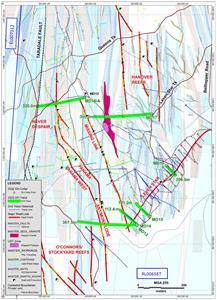
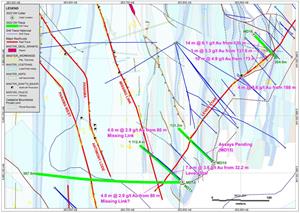
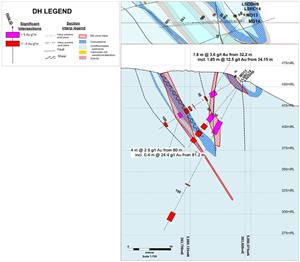
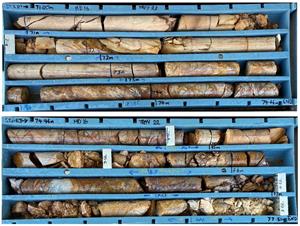
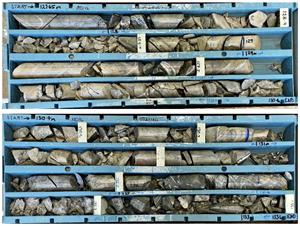
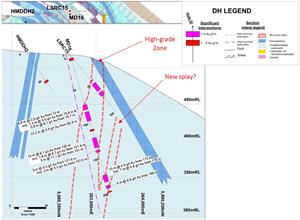
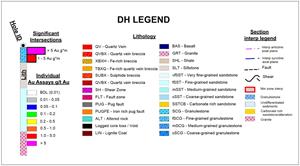


























I shudder to think how the stock would react if truly bad news was released…….
Down another 5% with todays news…….
Enough already!